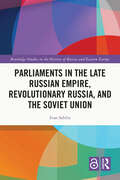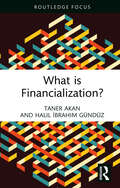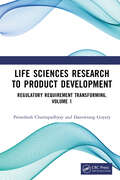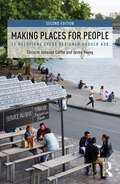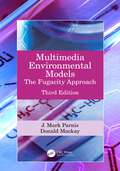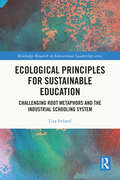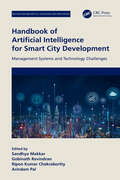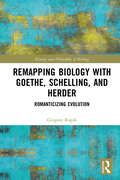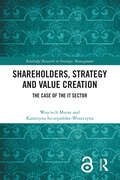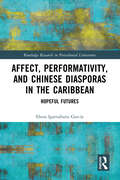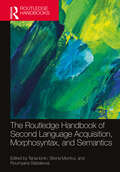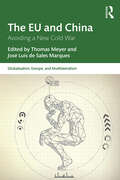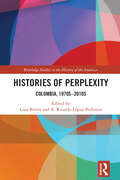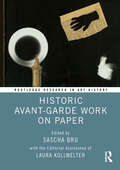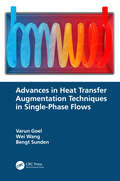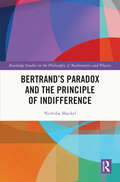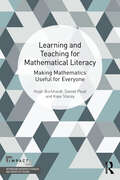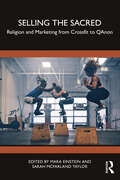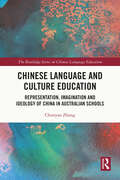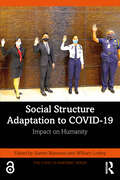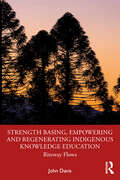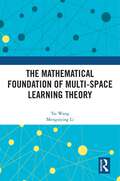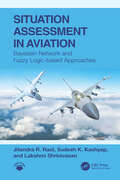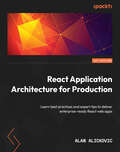- Table View
- List View
Parliaments in the Late Russian Empire, Revolutionary Russia, and the Soviet Union (Routledge Studies in the History of Russia and Eastern Europe)
by Ivan SablinThis book examines the meanings that were attached to the terms “parliament” and “parliamentarism” in the different historical and discursive contexts of the late Russian Empire, revolutionary and Soviet Russia, and the Soviet Union. It discusses those institutions referred to as parliaments by contemporaries, gives special attention to their functions, and traces the broader debates on parliamentarism within Russia and the Soviet Union, in Russian émigré circles, and among foreign observers. It highlights that only the late imperial and perestroika assemblies can be considered legislative institutions that expressed dissensus but argues that other assemblies, often referred to as “rubber-stamp” parliaments due to their lack of legislative competence and influence over other authorities, should not be dismissed. The Supreme Soviet, for instance, provided an integrative function binding society and elites in a top-down manner, while its deputies engaged in information acquisition and state micromanagement through interactions with their constituents. It also played an important role in interparliamentary relations and, as one of the first institutions of nominal parliamentarism in an autocratic single-party regime, of which there were many in the twentieth century, served as a model for numerous state socialist regimes. By addressing the role of parliaments in reassembling imperial spaces through political representation and the functions of nominal legislative institutions, the book explores the contribution of Russian and Soviet assemblies to global political modernity.
What is Financialization? (Routledge Frontiers of Political Economy)
by Taner Akan Halil İbrahim GündüzThis book introduces a new and original analytic approach to defining, understanding, and explaining financialization. It provides a precise and quantifiable definition of financialization, disaggregating financialization into its three varieties. These are examined through the lens of financial development, both before and after the Great Recession, providing the most in-depth analysis of the finance-real economy-labor nexus. It provides a historical perspective, looking at financialization as a key dynamic that has shaped real economic structures in terms of both growth and inequality of income over the last four decades in high-income, upper-middle-income, and lower-middle-income countries. The book makes its multidisciplinary content readily accessible to non-economists by providing economics background information, and to economists by providing social-theoretical context. It will be essential reading for academics, researchers, analysts, and students of economics, business, finance, sociology, politics, and international relations. It will also serve as a vital resource for policy-makers and bureaucrats in determining, formulating, implementing, and revising policy alternatives to govern the pros and cons of financial development in terms of its effects on real output and income inequality.
Life Sciences Research to Product Development: Regulatory Requirement Transforming, Volume 1
by Pronobesh Chattopadhyay Danswrang GoyaryThe present volume, Life Sciences Research to Product Development: Regulatory Requirement Transforming, Volume 1, discusses the procedures of drug approval and regulatory requirements that must be met according to the United States Food and Drug Administration (US FDA), the European Medical Agency (EMA), and the Central Drug Standard Control Organization (CDSCO). Many researchers either abandon their work in the middle of the process or find it difficult to follow the rules. Therefore, it is not surprising that any biological researcher associated with drug development should have a thorough understanding of regulatory requirements. This volume incorporates all the requisite regulatory norms and provides the latest information on the mandated regulation of herbal medicines.The book covers other obligatory regulatory requirements such as: The legal method and practice of herbal drug products, the roles of Ayurvedic medicines, and the process to obtain regulatory approval. Drug molecules not included in Department of Ayurveda, Yoga, Naturopathy, Unani, Siddha, and homeopathy (AYUSH) but referred to as phytopharmaceuticals are also considered new drugs. The boundary line between food and herbal pharmaceuticals is discussed, as well as pre-clinical toxicity testing, clinical trials, and stability studies in accordance with the rules. The chapter on regulatory implications for the approval process in this book will be the most useful resource for researchers and students, particularly those with backgrounds in pharma, forensic medicine, or regulatory affairs, or those who aspire to succeed in drug research. Additionally, the information contained in this volume of the book could be of great interest to researchers working in the herbal drug industry.
Making Places for People: 12 Questions Every Designer Should Ask
by Christie Johnson Coffin Jenny YoungMaking Places for People explores 12 social questions crucial to environmental design. Authors Christie Johnson Coffin and Jenny Young bring perspectives from practice and teaching to challenge assumptions about how places meet human needs. In this expanded second edition, the authors continue to explore the complexities of basic questions, such as: What is the story of this place? What logic orders it? How big is it? How sustainable is it? They consider the impact on making places of pandemic, climate change, human migration, and contemporary discussions of diversity, equity, and justice. Short, approachable, easy-to-read chapters, illustrated with updated examples of projects from around the world, bring together theory, methodology and key research findings. Understanding experienced and research-based connections between people and built form can inspire designs that make places of meaning and delight. This second edition will be essential reading for design students and professionals.
Multimedia Environmental Models: The Fugacity Approach
by J. Mark Parnis Donald MackayMultimedia Environmental Models: The Fugacity Approach, Third Edition, takes a broad approach of viewing chemical behavior in the total biosphere of connected biotic and abiotic compartments. Chemicals are subject to the laws of "mass balance," a constraint that provides the opportunity to establish quantitative expressions for chemical fate that are central to chemical management and regulatory legislation. This book employs both the conventional concentration-based procedures and those based on application of the more elegant and powerful concept of fugacity to characterize equilibrium, steady-state distribution, and time-dependent transport between environmental phases such as air, water, and soil. Organic chemicals are emphasized because they are more easily generalized when assessing environmental behavior.Features Illustrates professional approaches to calculating the fate of chemicals in the environment Explicitly details all worked examples in an annotated step-by-step fashion Presents real-life freely downloadable models of use to government, industry, and private consulting professionals and students alike Clarifies symbols and notation
Ecological Principles for Sustainable Education: Challenging Root Metaphors and the Industrial Schooling System (Routledge Research in Educational Leadership)
by Liza IrelandThis book explores how the education sector can transition to being truly sustainable and why necessary innovations for educational change are being subverted and undermined when mapped onto the existing industrial educational system.Based on PhD case study research with schools that are modelling and teaching sustainability, action research, and the author’s 40 years of working in the K-12 system, this volume examines how education continues to perpetuate the status quo, and why education innovations are thus undermined. It shows the importance of redesigning education based on the principles of sustainable living systems and explores how this can be achieved across all levels of the educational system. The first part of the book establishes a new vision of sustainable education, whilst the second brings to light the industrial mechanistic root metaphors in current practice across leadership and administration, buildings and grounds, curriculum design, teaching, and learning that are subverting innovative efforts. From understanding the foundational, influential, problematic root metaphors of our "Industrial" educational system, it moves to explore how the ecological principles of sustainability can be used to rethink and redesign an educational system, from its administration, leadership, and policy, to curriculum, buildings, grounds and resources, through to teaching and learning, that will support sustainability, innovation, and creativity, developing systems thinking and sustainability as a frame of mind.Exploring how the education sector can transition to being truly sustainable and find new ways to traverse the problematic "Industrial" world view at this pivotal moment, will appeal to administrators, post-secondary educators, policymakers, and researchers and scholars of sustainability education, educational leadership, curriculum design, and educational philosophy.
Handbook of Artificial Intelligence for Smart City Development: Management Systems and Technology Challenges (Big Data for Industry 4.0)
by Sandhya Makkar Gobinath Ravindran Ripon Kumar Chakrabortty Arindam PalThis handbook explores smart cities of the future, provides an understanding of their development and management systems, and discusses the technology challenges. It also discusses why and how humankind can benefit from them.Handbook of Artificial Intelligence for Smart City Development: Management Systems and Technology Challenges covers the whole journey of the development of smart cities, from the foundations to the usage of technologies, including the challenges and issues that policymakers and technologists may face during the concept, development, management, and implementation stage. The book also covers sustainable strategies and safety measures and offers real-life cases and advancements in manufacturing approaches for smart cities. The book includes upcoming AI technologies such as big data analytics, blockchain, machine learning, fault diagnostics, and a lot more.This handbook is intended to appeal to readers from industry and research. The book is also meant for academicians and students from across many disciplines. Moreover, this book is a medium for consultants, government agencies, and policymakers to grapple with topics and perspectives outside their lane
Remapping Biology with Goethe, Schelling, and Herder: Romanticizing Evolution (History and Philosophy of Biology)
by Gregory RupikRemapping Biology with Goethe, Schelling, and Herder recruits a Romantic philosophy of biology into contemporary debates to both integrate the theoretical implications of ecology, evolution, and development, and to contextualize the successes of the Modern Evolutionary Synthesis’s gene’s-eye-view of biology.The dominant philosophy of biology in the twentieth century was one developed within and for the Modern Evolutionary Synthesis. As biologists like those developing an Extended Evolutionary Synthesis have pushed the limits of this paradigm, fresh philosophical approaches have become necessary. This book makes the case that an organicism developed by the 19th century figures Goethe, Schelling, and Herder offers surprising resources to navigate the contemporary biological and evolutionary terrain. This “metamorphic organicism” resonates with present trends in biological theory that emphasize process, organismal dynamics, ecology, and agency. It also proposes strategies for reintegrating reductive and mechanistic maps of biology, like those of the Modern Evolutionary Synthesis, into richer theoretical representations of life.Drawing from cutting-edge biology, Romantic history, and perspectival pluralist literatures, this integrated history-and-philosophy-of-biology will be of interest to students and scholars interested in the genesis of current theoretical tensions in evolutionary biology, and to those seeking constructive ways to resolve those tensions, including practicing biologists and educators.
Shareholders, Strategy and Value Creation: The Case of the IT Sector (Routledge Research in Strategic Management)
by Wojciech Muras Katarzyna Szczepańska-WoszczynaThe central task of contemporary strategic management is to look for sources of value and to achieve above- average firm performance. The effective implementation of a value creation strategy requires a comprehensive approach, including the creation of a systemic management structure aimed at increasing company value.The concept of value- based management involves consciously inspiring, undertaking, and implementing value- oriented actions. Value creation takes place at all levels of management and in all organisational units of the company; therefore, the implementation of all management functions should be assigned to this goal. Thus, the role of managers is gaining importance, especially those who are capital- linked to companies, who set goals and verify them by means of informed decisions aimed at maximising value in the long term.The book presents a multidimensional analysis of shareholders’ impact on company value creation. The authors chose the IT sector as the area of study; this sector, being one in which modern technologies are essential, acquires special significance for the global economy.The book features a review of notions and concepts related to the management of company value and methods of measuring it, the shareholder’s impact on the creation of company value, and factors affecting long- term value creation; an analysis of the places of occurrence, power and direction of a shareholder’s impact on building the long- term capacity of an IT sector company for creating the value thereof, as well as the conceptualisation and operationalisation of such impact; an analysis of the role of shareholders in IT sector companies, a profile of shareholder competence which makes the role of a shareholder unique to the company and fulfils the “value- creating owner” postulate; an analysis of the role of hired managers cooperating with the shareholders with an indication of the significance of mutual development and the supplementation of one’s own skills.The book is dedicated to scientists in the field of strategic management, valuebased management, and leadership; shareholders; students of EMBA and MBA programmes; practitioners in strategic management; and current shareholders of modern technology companies (in particular from the IT sector) and future investors, for all of whom it may offer a valuable outlook on the management principles and practices in the sectors, particularly with respect to the long- term creation of company value.The Open Access version of this book, available at www.taylorfrancis.com, has been made available under a Creative Commons Attribution-Non Commercial-No Derivatives (CC-BY-NC-ND) 4.0 International license.
Affect, Performativity, and Chinese Diasporas in the Caribbean: Hopeful Futures (Routledge Research in Postcolonial Literatures)
by Elena Igartuburu GarcíaAffect, Performativity, and Chinese Diasporas in the Caribbean: Hopeful Futures analyzes the emergence of Chinese diasporic literature and art in the Caribbean and its diasporas in the twenty-first century. This book considers the historical and critical discourse about the Chinese diasporas in the Caribbean and proposes a textual and visual archive selecting contemporary texts that signal a changing paradigm in postcolonial literature at the turn of the twenty-first century. Whereas, historically, Chinese minorities had been erased or presented as ultimate Others, contemporary texts mobilize Chinese characters and their stories strategically to propose alternative configurations of community and belonging grounded in affective structures and contest the coloniality of national imaginaries.
The Routledge Handbook of Second Language Acquisition, Morphosyntax, and Semantics (The Routledge Handbooks in Second Language Acquisition)
by Tania Ionin, Silvina Montrul, and Roumyana SlabakovaThis handbook provides innovative and comprehensive coverage of research on the second language acquisition (SLA) of morphosyntax, semantics, and the interface between the two.Organized by grammatical topic, the chapters are written by experts from formal and functional perspectives in the SLA of morphosyntax and semantics, providing in-depth yet accessible coverage of these areas. All chapters highlight the theoretical underpinnings of much work in SLA and their links to theoretical syntax and semantics; making comparisons to other populations, including child language acquirers, bilinguals, and heritage speakers (links to first language acquisition and bilingualism); dedicating a portion of each chapter to the research methods used to investigate the linguistic phenomenon in question (links to psycholinguistics and experimental linguistics); and, where relevant, including intervention studies on the phenomenon in question (links to applied linguistics).The volume will be indispensable to SLA researchers and students who work on any aspect of the SLA of morphosyntax or semantics. With its coverage of a variety of methodologies and comparisons to other populations (such as child language acquirers, early bilinguals, heritage speakers, and monolingual adults), the handbook is expected to also be of much interest to linguists who work in psycholinguistics, first language acquisition, and bilingualism.
The EU and China: Avoiding a New Cold War (ISSN)
by Thomas Meyer José Luís de Sales MarquesThis edited book is devoted to an analysis of how the multiple modernities approach might help strengthen the strategic autonomy of the European Union and foster cooperative EU–China relations at a time when some observers believe that a new global cold war may be on the horizon. An international, interdisciplinary team of eminent scholars analyzes both the forces causing dangerous tensions to escalate and those that might stabilize the situation. Whether from China or Europe, the authors largely converge in their diagnoses. To serve its own vital interests, the EU can and must play the role of a politically independent actor, a mediator committed to the preservation of a fair and peaceful rules-based order. To do that, it must first pinpoint the economic and political concerns that it shares with both China and the USA, using them as guidelines in developing its own global strategies. The chapters collected in this volume try to shed light on that endeavor. Additionally, several aim to clarify China’s true intentions in international politics, beyond the rhetoric of conflict in which all parties presently engage. What role does Asia’s leading power actually aspire to play in world politics?The book will be of interest to students of history, international relations, international political economy, European and Chinese studies, and military and security affairs.Furthermore, its timely subject should stimulate debate among a wider audience of journalists, policy professionals, and politically engaged readers the world over.
Histories of Perplexity: Colombia, 1970s-2010s (Routledge Studies in the History of the Americas)
by Lina Britto A. Ricardo López-PedrerosBy combining chronological coverage, analytical breadth, and interdisciplinary approaches, these two volumes—Histories of Solitude and Histories of Perplexity—study the histories of Colombia over the past two centuries as illustrations of the histories of democracy across the Americas.The volumes bring together over 40 scholars based in Colombia, the United States, England, and Canada working in various disciplines to discuss how a country that has been consistently presented as a rarity in Latin America provides critical examples to re-examine major historical problems: republicanism and liberalism; export economies and agrarian modernization; populism and cultural politics of state formation; revolutionary and counterinsurgent Cold War violence; neoliberal reforms and urban development; popular mobilization and counterhegemonic public spheres; political ecologies and environmental struggles; and labors of memory and the challenge of reconciliation. Contributors are sensitive to questions of subjectivity and discourse, observant of ethnographic details and micro-politics, and attuned to macro-perspectives such as transnational and global histories.These volumes offer fresh perspectives on Colombia and will be of great value to those interested in Latin American and Caribbean history.
Historic Avant-Garde Work on Paper (Routledge Research in Art History)
by Sascha Bru Laura KollwelterThis book examines the many functions of paper in the fine art and aesthetics of the early twentieth-century modernist or historic avant-garde (Expressionism, Cubism, Futurism, Dadaism, Surrealism, Constructivism and many more).With its many collages and photomontages, the historic avant-garde is generally considered to have transformed paper from a mere support into an artistic medium and to have assisted in art on paper gaining a firm autonomy. Bringing together an international team of scholars, this book shows that the story of paper in the avant-garde has thereby hardly been told. The first section looks at a selection of canonized individual avant-gardists’ work on paper to demonstrate that the material and formal analysis of paper in the avant-garde’s artistic production still holds much in store. In the second section, chapters zoom in on forms and formats of collective artistic production that deployed paper to move around reproductions of fine art works, to facilitate the dialogue between avant-gardists, to better promote their work among patrons, and to make their work available to a wider audience. Chapters in the third section lay bare how certain groups within the avant-garde began to massively create monochrome works, because these could be easily reproduced when transferred to, or reproduced as, linocuts. In the last section of the book, chapters explore how the avant-garde’s attentiveness to paper almost always also implied a critique of the ways in which paper, and all that it stood for, was treated and labored in European culture and society more broadly.The book will be of interest to scholars working in art history, modernism, and design.
Advances in Heat Transfer Augmentation Techniques in Single-Phase Flows
by Varun Goel Wei Wang Bengt SundenAugmentation of heat transfer is important in energy conservation and developing sustainable energy systems. This book provides the science necessary to understand the basics of heat transfer augmentation in single-phase engineering systems. It considers theory and practice including computational and experimental procedures, evaluation techniques for performance, and new trends. Several applications of augmentation methods like surface modification, introduction of vortex flow and impinging jets, opportunities of ultrasound and magnetic fields, pulsatile flows, heat exchangers, and nanofluids are provided. Details of basic phenomena and mechanisms are highlighted.Key features: Provides the fundamental science needed to understand and further develop heat transfer augmentation for future energy systems Give examples of how ultrasound and magnetic fields, vortex flow, impinging jets, surface modification and nanofluids can augment heat transfer Considers basic issues of computational and experimental methods for analysis, design, and evaluation of efficient and sustainable heat transfer It is an ideal reference text for graduate students and academic researchers working in the fields of mechanical, aerospace, industrial, manufacturing, and chemical engineering.
Bertrand’s Paradox and the Principle of Indifference (Routledge Studies in the Philosophy of Mathematics and Physics)
by Nicholas ShackelEvents between which we have no epistemic reason to discriminate have equal epistemic probabilities. Bertrand’s chord paradox, however, appears to show this to be false, and thereby poses a general threat to probabilities for continuum sized state spaces. Articulating the nature of such spaces involves some deep mathematics and that is perhaps why the recent literature on Bertrand’s Paradox has been almost entirely from mathematicians and physicists, who have often deployed elegant mathematics of considerable sophistication. At the same time, the philosophy of probability has been left out. In particular, left out entirely are the philosophical ground of the principle of indifference, the nature of the principle itself, the stringent constraint this places on the mathematical representation of the principle needed for its application to continuum sized event spaces, and what these entail for rigour in developing the paradox itself. This book puts the philosophy and its entailments back in and in so doing casts a new light on the paradox, giving original analyses of the paradox, its possible solutions, the source of the paradox, the philosophical errors we make in attempting to solve it and what the paradox proves for the philosophy of probability. The book finishes with the author’s proposed solution—a solution in the spirit of Bertrand’s, indeed—in which an epistemic principle more general than the principle of indifference offers a principled restriction of the domain of the principle of indifference.Bertrand's Paradox and the Principle of Indifference will appeal to scholars and advanced students working in the philosophy of mathematics, epistemology, philosophy of science, probability theory and mathematical physics.
Learning and Teaching for Mathematical Literacy: Making Mathematics Useful for Everyone (IMPACT: Interweaving Mathematics Pedagogy and Content for Teaching)
by Hugh Burkhardt Daniel Pead Kaye StaceyTypically, most people don’t realize when and how they can use the mathematics they were taught in high school – yet many of the mathematical ideas and skills can be a powerful tool for understanding how the world works. Learning and Teaching for Mathematical Literacy addresses this situation, offering practical strategies for developing a broader vision of mathematical literacy in the classroom and recognising the importance of maintaining these skills into adult life. Linked to the material explored throughout this book, classroom activities and lesson materials are freely available for use via the QR codes included in each chapter.Filled with case studies and classroom activities, chapters tackle several topics: Describing a framework for a broader vision of mathematical literacy – what is it, and why is it important? Teaching mathematical literacy in the classroom Applying mathematical literacy to ‘real life’ scenarios: My dad is buying a new dishwasher. Should he buy the extended warranty on offer? My phone works fine but I've been offered an upgrade. How should I decide whether to take it? The role of technology in teaching mathematical literacy Designing mathematical measures for real-word quantities Firmly grounded by practical applications for the classroom and beyond, this is an essential handbook for any teacher, teaching assistant, or mathematics subject lead who wishes to develop their students’ mathematical literacy skills. This is also an ideal resource for those delivering or enrolled in teacher preparation courses.
Selling the Sacred: Religion and Marketing from Crossfit to QAnon
by Mara Einstein Sarah McFarland TaylorThere’s religion in my marketing! There’s marketing in my religion! Selling the Sacred explores the religio-cultural and media implications of a two-sided phenomenon: marketing religion as a product and marketing products as religion. What do various forms of religion/marketing collaboration look like in the twenty-first century, and what does this tell us about American culture and society?Social and technological changes rapidly and continuously reframe religious and marketing landscapes. Crossfit is a “cult.” Televangelists use psychographics and data marketing. QAnon is a religion and big business. These are some of the examples highlighted in this collection, which engages themes related to capitalist narratives, issues related to gender and race, and the intersection of religion, politics, and marketing, among other key issues.The innovative contributors examine the phenomenon of selling the sacred, providing a better understanding of how marketing tactics, married with religious content, influence our thinking and everyday lives. These scholars bring to light how political, economic, and ideological agendas infuse the construction and presentation of the “sacred,” via more traditional religious institutions or consumer-product marketing. By examining religion and marketing broadly, this book offers engaging tools to recognize and unpack what gets sold as “sacred,” what’s at stake, and the consequences.A go-to resource for those working in marketing studies, religious studies, and media studies, Selling the Sacred is also a must-read for religious and marketing professionals.
Chinese Language and Culture Education: Representation, Imagination and Ideology of China in Australian Schools (The Routledge Series on Chinese Language Education)
by Chunyan ZhangAgainst the background of the Australian government’s strategic plan to promote Asian languages in schools, this book is an innovative autoethnographic inquiry into what actually occurs in the implementation of a Chinese language and culture program in an Australian context.Drawing on eight years of socio-cultural and educational fieldwork in a primary school, Chunyan Zhang examines complex, fluid and heterogeneous daily teaching practices and the ways in which ideas of China are assembled, presented and performed. She asks the following questions: What is China? Where does Taiwan fit into the China depicted in a multicultural, globalised classroom? Can Chinese communism or Chairman Mao be avoided in teaching English-speaking learners? What kind of China is brought in here while what kind of China is being silenced and othered? Through the partial connection between method assemblage and Daoist concepts, Zhang develops a water-like pedagogy in teaching. She uses the knowledge flow model to examine the imbalanced knowledge flow within teacher-student interactions. From finding China as a hybrid assemblage to proposing China as method, Zhang’s investigation makes an important contribution to the sociology of Chinese language education.This book is an essential and rich content resource for primary and secondary teacher education and research, teacher candidates and educators in Chinese as a second language education.
Social Structure Adaptation to COVID-19: Impact on Humanity (The COVID-19 Pandemic Series)
by Suresh Nanwani William LoxleySocial Structure Adaptation to COVID-19 offers global, interdisciplinary perspectives that examine how the COVID-19 pandemic has altered the development trajectory of schools, public health, the workforce, and technology adoption. It explores social themes in society, economy, policy, and culture and draws on a social framework to describe key functions of societal adaptation to the pandemic.Edited by Suresh Nanwani and William Loxley, the volume is grounded in the study of system components and their objectives to improve overall well-being given the ill effects of the COVID-19 pandemic. Chapters explore interconnected social networks and how sectors restructured themselves to stabilize or transform society. International contributors from 20 countries offer case studies that highlight key themes including personal connectivity, societal equality, well-being, big data, and national resilience. They predict how impactful the pandemic might be in reshaping the future and assess how the COVID-19 pandemic has affected school system shutdown, public health collapse, business closures, public policy failure, and technology-driven social media acceleration.Offering insights into how institutions and sectors work together in times of crisis, and how COVID-19 has restructured social behavior, Social Structure Adaptation to COVID-19 will be valuable reading for scholars and students of sociology, political science, anthropology, comparative international development, psychology, and education. It will also be of interest to policymakers concerned with education, work and organizations, and media and technology.The Open Access version of this book, available at www.taylorfrancis.com, has been made available under a Creative Commons Attribution-Non Commercial-No Derivatives (CC-BY-NC-ND) 4.0 international license.
Strength Basing, Empowering and Regenerating Indigenous Knowledge Education: Riteway Flows
by John DavisStrength Basing, Empowering and Regenerating Indigenous Knowledge Education demonstrates how to bring Indigenous Knowledges to the forefront of education practice and provides educators with the tools to enact culturally responsive curricula and pedagogies, ensuring positive educational outcomes for Aboriginal and Torres Strait Islander children and students. In this book, John Davis presents Indigenous Knowledges – ways of doing, creating, and learning – combined with contemporary education practice, to develop a culturally responsive pedagogy that builds on the strengths that Indigenous Australian students bring to the classroom. Setting Cultural Proficiency as the benchmark, the book offers educators a lens through which to review their education practice. It moves beyond the deficit model of Indigenous education by challenging non-Indigenous educators to reflect on personal biases and to raise their expectations of Indigenous students. Not ‘tacked on’ to an existing curriculum, or specific to a single school term or unit of learning, Riteway places Indigenous Knowledges at the centre of education. The approach is holistic and adaptable to any educational context, from the early years right through to tertiary education. Providing a roadmap toward transformational education for Aboriginal and Torres Strait Islander children and students, this book will be essential reading for pre- and in-service educators alike.
The Mathematical Foundation of Multi-Space Learning Theory
by Tai Wang Mengsiying LiThis book explores the measurement of learning effectiveness and the optimization of knowledge retention by modeling the learning process and building the mathematical foundation of multi-space learning theory.Multi-space learning is defined in this book as a micro-process of human learning that can take place in more than one space, with the goal of effective learning and knowledge retention. This book models the learning process as a temporal sequence of concept learning, drawing on established principles and empirical evidence. It also introduces the matroid to strengthen the mathematical foundation of multi-space learning theory and applies the theory to vocabulary and mathematics learning, respectively. The results show that, for vocabulary learning, the method can be used to estimate the effectiveness of a single learning strategy, to detect the mutual interference that might exist between learning strategies, and to predict the optimal combination of strategies. In mathematical learning, it was found that timing is crucial in both first learning and second learning in scheduling optimization to maximize the intersection effective interval.The title will be of interest to researchers and students in a wide range of areas, including educational technology, learning sciences, mathematical applications, and mathematical psychology.
Situation Assessment in Aviation: Bayesian Network and Fuzzy Logic-based Approaches
by Jitendra R. Raol Sudesh K. Kashyap Lakshmi ShrinivasanSituation Assessment in Aviation focuses on new aspects of soft computing technologies for the evaluation and assessment of situations in aviation scenarios. It considers technologies emerging from multisensory data fusion (MSDF), Bayesian networks (BN), and fuzzy logic (FL) to assist pilots in their decision-making.Studying MSDF, BN, and FL from the perspective of their applications to the problem of situation assessment, the book discusses the development of certain soft technologies that can be further used for devising more sophisticated technologies for a pilot's decision-making when performing certain tasks: airplane monitoring, pair formation, attack, and threat. It explains the concepts of situation awareness, data fusion, decision fusion, Bayesian networks, fuzzy logic type 1, and interval type 2 fuzzy logic. The book also presents a hybrid technique by using BN and FL and a unique approach to the problem of situation assessment, beyond visual range and air-to-air combat, by utilizing building blocks of artificial intelligence (AI) for the future development of more advanced automated systems, especially using commercial software.The book is intended for aerospace R&D engineers, systems engineers, aeronautical engineers, and aviation training professionals. It will also be useful for aerospace and electrical engineering students taking courses in Air Traffic Management, Aviation Management, Aviation Operations, and Aviation Safety Systems.
Team Player (Wondergirls #2)
by Jillian BrooksME, competitive? Can I help it if I score the MOST goals, wear the COOLEST clothes, and throw the best PARTIES? I'm not competitive... that's just who I am. And I'm definitely not SELFISH. So how come certain people—like my BEST friends—keep telling ME that I am? I can be NICE... When I feel like it. RL 4 Ages 8-12 Look for the other books in the wondergirls series about the friendship of four girls at home and at middle school including: #1 The New Girl, #3 Troublemaker, #4 "And The Winner Is...", #5 Perfect Harmony, and #7 Birthday Blues, with more on the way
React Application Architecture for Production: Learn best practices and expert tips to deliver enterprise-ready React web apps
by Alan AlickovicA hands-on guide to help you develop skills and confidence in building and structuring React applications in a well-organized way using the best tools in the React ecosystemKey FeaturesDiscover solutions to complex problems faced while creating production-ready apps with ReactDevelop scalable React applications with Next.js using a step-by-step approach from analysis to deploymentGet an overview of the React ecosystem and identify the best tools to meet your app requirementsBook DescriptionBuilding large-scale applications in production can be overwhelming with the amount of tooling choices and lack of cohesive resources. To address these challenges, this hands-on guide covers best practices and web application development examples to help you build enterprise-ready applications with React in no time.Throughout the book, you'll work through a real-life practical example that demonstrates all the concepts covered. You'll learn to build modern frontend applications—built from scratch and ready for production. Starting with an overview of the React ecosystem, the book will guide you in identifying the tools available to solve complex development challenges. You'll then advance to building APIs, components, and pages to form a complete frontend app. The book will also share best practices for testing, securing, and packaging your app in a structured way before finally deploying your app with scalability in mind.By the end of the book, you'll be able to efficiently build production-ready applications by following industry practices and expert tips.What you will learnUse a good project structure that scales well with your applicationCreate beautiful UIs with Chakra UI and emotionConfigure a base Next.js app with static code analysis and Git hooksLearn to mock API endpoints for prototyping, local development and testingChoose an optimal rendering strategy in Next.js based on the page needsLearn to choose the best state management solution for given problemWrite unit tests, integration tests and e2e tests in your React ApplicationDeploy your React applications on VercelWho this book is forThis book is for intermediate-level web developers who already have a solid understanding of JavaScript, React, and web development in general and want to build large-scale React applications effectively. Beginner-level TypeScript experience, along with JavaScript and React, will be beneficial.
